The 2mm debate - agronomic investigation
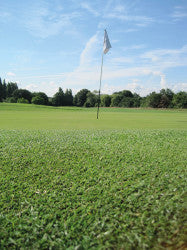
The problem was that there was no scientific data to back up my shortcut method. I knew that it worked (from a player's perspective), but was unable to point to a reliable source that explained why. However, there was also no evidence to say that it couldn't work.
We'd all heard stories of greenkeepers who had lost their greens because they had been cutting them too short. Lots of stories, but no facts!
As the debate began I started some agronomic tests. By compiling the results, I hoped to produce a body of data that would go some way to proving my method. From the start I looked at what a 2mm method could achieve from an agronomic point of view. I felt that a short cutting regime in a parkland environment could reduce organic matter levels and help in the prevention of disease attack. The other thing that intrigued me was the bad press that Poa annua has had over the years, contrary to my positive experiences of it.

- Organic Matter levels
- Soil and Tissue nutrient analysis
- CEC and pH values
- Percolation rates
- Compaction levels
- Bulk density
- Sward density
Ealing Golf Club's Greens Profile
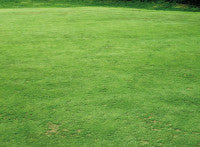
The greens are roughly 8000m² in total and drainage on the greens is pretty non-existent, as old clay pipes form the land drainage. Some of these can be located one metre deep but, instead of pea shingle covering them, we have hard core!

The Data Programme
All of my data has been taken from our second green. It is 450m² and in a fairly open position. The back drains pretty well, but the front of the green can get quite wet. The grass species is 99% Poa annua and 1% Browntop Bent (I'm doing my best to get rid of that 1%).
Organic Matter
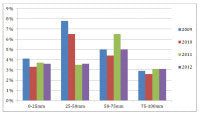
This is the industry accepted 'Loss on Ignition' test, externally conducted by European Turfgrass Laboratories based in Stirling. The results are shown above.
As shown by the graph, over the years the OM levels in the greens have been controlled with the greatest improvement in the 25 to 50mm layer. Although I have no doubt that the sand and aeration programme has played a part, I think that the tight height of cut has helped too. In 2006, the grass plant that I inherited was a fat, beefed up Poa Annua cut at 5mm. The tighter I cut, the finer the species seemed to become. I regret that I didn't conduct OM tests back then, as I am sure the figures would have been a lot higher.
Soil and tissue tests, plus pH and CEC values
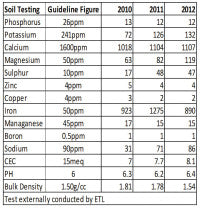
When compiling the nutrient analysis data, instead of concentrating solely on soil analysis (which is the norm), tissue samples are also collated. This gives me a better overall view of what is actually going on inside the plant.
I annually conduct these tests independent of fertiliser companies. The results tell me a lot:

As soon as I started performing these tissue tests rather than soil tests, this whole area started to make sense. All of a sudden elements such as P, K and Ca were not under, and Fe and S were okay too. If you looked at the soil test figure for Manganese, it came in at around 15ppm, way under the accepted level. One fertiliser company tried to get me on a Manganese programme at a cost of over £1k per year. But, as soon as the tissue tests results came in, I could see that what was actually in the plant was okay, and I didn't have to spend lots of money to correct the element levels.
Percolation rates
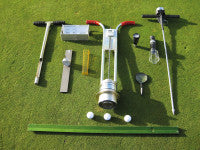
On old courses, such as ours at Ealing, it is very hard to achieve. Over time, the percolation rates of the greens naturally slow down as OM levels build up. The drainage system in our greens was pretty antiquated, and installing a new system was outside the club's budget. The only option that I could see was the 'deep aeration and sand' approach which would, at least, get the rootzone functioning again. But, how did I know that this method was working? I could see that the top surface was firming up, and that waterlogged greens were a thing of the past, but I wanted data.
The Infiltrometer uses the double ring system. It has a ball resting on the top and a gauge that measures the downward movement of water in mm/hr. I test the percolation rates every month in three positions on the green. Before I begin, I saturate the rootzone for at least ten minutes to make sure I get a 'true' saturated reading. These are the average annual results:
- 2010 - 31mm/hr
- 2011 - 28mm/hr
- 2012 - 39mm/hr
As you can see, there was a slight dipin 2011, but improvement was vast in 2012, even with the greens being pretty much saturated due to heavy rainfall. It will be interesting to see whether the trend continues.
Compaction

As soon as the test was implemented, I could see that there was a slight pan between the 100 and 200mm layer. Over the years, the aeration of the greens was channeled in this range as that was what the machinery capabilities allowed for. Based on the results, from 2010 we started to aerate above 100mm (shallow aeration) and below the 200mm layer (deep aeration). Now, when I put the penetrometer into the greens, I feel it sliding through the 100-200mm range, instead of feeling resistance.
Sward Density
My last agronomic test measures sward density by recording the number of leaves in a randomly selected 2cm². As with the other in-house tests, it is conducted monthly and the average results for each year are as follows:
- 2010 - 104 plants in a 2cm²
- 2011 - 116 plants in a 2cm²
- 2012 - 102 plants in a 2cm²
The density of the sward appears fairly consistent over the years, with a slight increase in 2011. I observed that, if I took a reading after a granular application of fertiliser, the numbers would shoot up but, after a foliar application, the numbers were very consistent. It proves, once again, that to produce consistent growth, little and often applications of fertiliser are needed instead of giving it all at once.

In the past, I have been criticised for not giving the full picture. So, in the spirit of full disclosure, and before I go on to my observations and conclusions, here is the full greens maintenance programme at Ealing Golf Club:
Conclusions
Collating this data over the last three years has taught me a lot about my own greenkeeping methods. A lot of questions were raised by the 2mm debate, but I had no way to prove my results. My method was based largely on 'gut feeling'. The method obviously works, and is successful, but I made many mistakes and could have saved time and money if the data had been readily available. With three years hindsight, I conclude the following:
- To produce top greens performance (playability and agronomy) the feeding programme has to be right. By analysing plant tissue, as well as testing the soil, I can fine tune greens growth. I stopped panicking about what was going on inside the plant. If you look at my soil results, you can see many nutrients were way out of their guideline figure. However, once I started collating tissue samples, I could see that they were plentiful inside the plant and expensive fertiliser to add nutrients wasn't required.
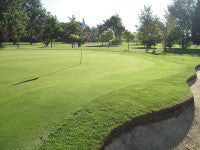
- Using accurate organic matter information, I targeted aeration and sanding where it was needed. One of the biggest concerns with heavy sanding is that you can bury the OM in the profile, but using tools such as the penetrometer and having OM samples tested at certain depths, you can gauge where your troublesome spots are and act accordingly.
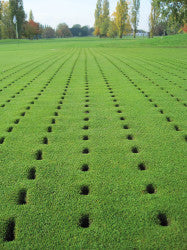
- When I became CM at Ealing in 2006, I overseeded a lot with colonial bent. This was to help support the Poa (which was weak) and create a dense sward. However, just before the data programme started, I totally stopped overseeding as I felt that the Poa was strong and would support itself. Plus, the seed cost a bloody fortune! The big concern is that, when you stop overseeding, sward density can suffer. That is why I include a density test in my programme. The sward stays dense as long as the Poa is healthy. Again, making sure your feeding programme is spot on is key to the success of this.
- Our fungicide bill has come down from a high of £10k (viewed from past records) in 2004 to £2.4k for each of the last three years. Firming the surfaces up with good cultural practices, such as sand and aeration, has helped, but a tighter cutting height than previous regimes also created a drier top surface.
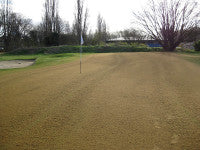
Personally, I am glad that I decided to implement this data programme. I find that it has taken the guesswork out of greenkeeping and, ultimately, allowed Ealing's greens to improve further. It perhaps goes a small way to proving that a 2mm cutting height works. I hope that anyone considering this type of regime finds my information useful and that, in the future, more of us can share our findings for the benefit of the industry.
If you have questions on this article you can contact Greg by email: gregevansmg@gmail.com, by phone: 07951 157208 or via his website: www.gregevansmg.com
For the complete story, you may wish to read previous articles. These can be found on our website by searching the author's name.
